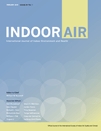A recent microbe.net post discussed the use of copper as an antimicrobial to prevent infections in healthcare settings. This is not a particularly new concept, but unfortunately, the literature appears dominated by authors who received funding from the copper industry and its associations. Such industrial funding is not unique to copper and is, sadly, more …
Illustration (from OpenScar.com) an explanation of the beginning of the spread of SARS in Hong Kong’s Amoy Gardens apartment complex where the index case was in a building 60 meters away from a building where about 45% of the 300 infected individuals at Amoy Gardens lived. Many of the other infected individuals also lived in …
Great two-part interview with Rich Corsi from UT Austin talking about indoor air quality. If you’re the kind of person who stays in your house because you’re worried about the air quality outside… don’t listen to this interview because then you’ll have nowhere left to hide. First segment (starts at 9 minutes, 40 seconds) Second …
A just-published article by Desroches et al, “Extrolites of Wallemia sebi, a very common fungus in the built environment,”in the journal Indoor Air describes a previously unidentified metabolite of Wallemia sebi , a very common fungus in houses worldwide, although relatively more common in north temperate climates. The authors (including David Miller) write that it …
Health care associated infections (HAIs) also known as nosocomial infections occurred in 4.5 out of every 100 hospital admissions in 2002 and contributed to 99,000 deaths (Klevens 2002). In the past many prevention strategies have focused on human based transmission (such as consistent hand washing) ignoring less obvious preventative measures such as those involving a …
Researchers in Italy have found abnormally high levels of infectious microbes in the water from faucets at two hospitals compared to water coming in from the deeper areas of the pipes. One of the reasons is that the water is not meeting the chlorine or temperature requirement needed to eliminate harmful pathogens, such as Acinetobacter …
Not surprisingly, the skin microbiome changes accordingly with human contact, according to this study found through PeerJ. Researchers aimed to study a high contact sport and see how the skin microbiome changes before and after a game. They used roller derby, and as anyone who has watched the movie Whip it! will know, there is a …
I was recently encouraged to post this video I made with a couple of classmates while I was in graduate school at the University of Texas at Austin (the other “actors” are Laura Reed, now a PhD student in water resources at Tufts University, and Sarah Taylor Lange, who just finished her PhD in concrete …
Many indoor environmental investigators have attempted to use volatile organic compounds (VOCs) emitted by microbes as an indicator of the presence or potential health relevance of the indoor microbiome. These compounds emitted by microbes are generally referred to as MVOCs. The airborne concentrations of MVOCs is usually too low for characterization by the usual indoor …
First of all, Happy Halloween everyone. I think my costume this year will be a blogger! For those that don’t know me, I’m Brent Stephens, an assistant professor in the Department of Civil, Architectural and Environmental Engineering at Illinois Institute of Technology in Chicago, IL. I call my research team the Built Environment Research Group …
